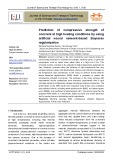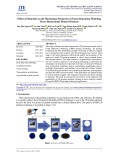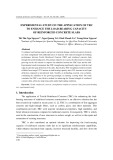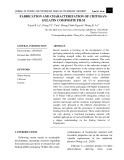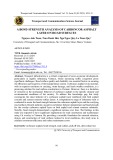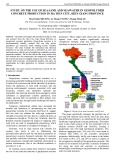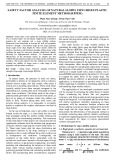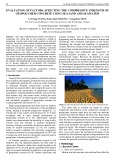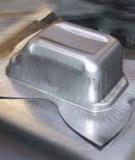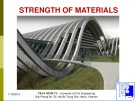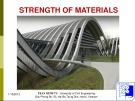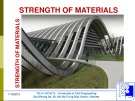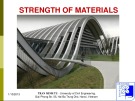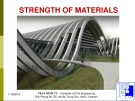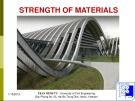
Strength of materials
-
This study investigates the compressive performance and mechanical behavior of concrete filled steel tubular (CFST) columns constructed with high strength materials under various compression loading scenarios.
 15p
15p  visarada
visarada
 28-04-2025
28-04-2025
 0
0
 0
0
 Download
Download
-
In this study, an artificial neural networkbased Bayesian regularization (ANN) model is proposed to predict the compressive strength of concrete. The database in this study includes 208 experimental results synthesized from laboratory experiments with 9 input variables related to temperature change and design material composition.
 12p
12p  viengfa
viengfa
 28-10-2024
28-10-2024
 2
2
 2
2
 Download
Download
-
This study evaluates the three-dimensional (3D) printing materials used in Fused Deposition Modeling (FDM) printing technology. 3D printing technology has been developing strongly, becoming an effective support tool in production and research.
 11p
11p  viinuzuka
viinuzuka
 28-02-2025
28-02-2025
 3
3
 1
1
 Download
Download
-
To enhance load-bearing capacity and prevent structural damage, reinforced concrete elements are often strengthened with additional layers of material. This study investigates the bonding performance between Textile Reinforced Concrete (TRC) and reinforced concrete slabs through four-point bending tests.
 12p
12p  viyamanaka
viyamanaka
 06-02-2025
06-02-2025
 4
4
 1
1
 Download
Download
-
Recent research is focusing on the development of bio-packaging materials by mixing different polymers to enhance the bonding strength within the matrix and combining favorable properties of the constituent materials. This work developed a bio-packaging material by combining chitosan, gelatin, and glycerol.
 10p
10p  viyamanaka
viyamanaka
 06-02-2025
06-02-2025
 4
4
 2
2
 Download
Download
-
The findings in this study are expected to have significant implications for road construction and maintenance using CA overlay in Vietnam. By providing a scientific foundation for material selection, design, and construction of road surfaces tailored to local conditions, this study aims to enhance investment efficiency and reduce maintenance costs.
 11p
11p  viyamanaka
viyamanaka
 06-02-2025
06-02-2025
 8
8
 2
2
 Download
Download
-
The article investigates the potential of using sea sand and seawater from Ha Tien City, Kien Giang Province, in geopolymer concrete production. Geopolymer concrete is an environmentally friendly material that can help reduce greenhouse gas emissions while utilizing locally available resources.
 5p
5p  vibenya
vibenya
 31-12-2024
31-12-2024
 11
11
 2
2
 Download
Download
-
In this study, a new method for analyzing safety factor (Fs) of natural slopes was developed. Rigid-plastic constitutive equation for soil materials and a slope stability analysis framework were formulated to account for both soil properties and slope geometry (slope angle β and slope height H).
 6p
6p  vibenya
vibenya
 31-12-2024
31-12-2024
 5
5
 2
2
 Download
Download
-
This study comprehensively analyzes the impact of temperature and curing time on the compressive strength of geopolymer concrete made with locally sourced sea sand and seawater. The research aims to utilize abundant regional materials while reducing the environmental footprint associated with traditional construction practices.
 5p
5p  vibenya
vibenya
 31-12-2024
31-12-2024
 6
6
 2
2
 Download
Download
-
Metal forming to make large parts, take large reductions, use high strength materials, work to net shape (precision flashless closed die forging), and use cold forming to obtain certain physical properties all require high forming forces. These forces may be larger than the capacity of existing machinery.
 33p
33p  vcuong222
vcuong222
 13-05-2015
13-05-2015
 61
61
 5
5
 Download
Download
-
Chapter 5 - Geometric properties of an area. The following will be discussed in this chapter: First moment of area, moment of inertia for an area, moment of inertia for some simple areas, parallel - axis theorem.
 21p
21p  larachdumlanat122
larachdumlanat122
 28-11-2020
28-11-2020
 27
27
 2
2
 Download
Download
-
Lecture Strength of Materials I - Chapter 7: Bending. The following will be discussed in this chapter: Introduction, bending stress, shearing stress in bending, strength condition, sample problems, deflections of beam, statically indeterminate beams.
 58p
58p  larachdumlanat122
larachdumlanat122
 28-11-2020
28-11-2020
 50
50
 2
2
 Download
Download
-
Lecture Strength of Materials I - Chapter 1: Introduction – Concept of stress. The following will be discussed in this chapter: Review of static, equilibrium of deformable body, concept of stress, stress under general loadings, strain, types of loading, assumptions, principle superposition.
 63p
63p  larachdumlanat122
larachdumlanat122
 28-11-2020
28-11-2020
 52
52
 1
1
 Download
Download
-
Chapter 2 - Axial force, shear force and bending moment. The following will be discussed in this chapter: Internal stress resultants; relationships between loads, shear forces, and bending moments; graphical method for constructing shear and moment diagrams; normal, shear force and bending moment diagram of frame.
 41p
41p  larachdumlanat122
larachdumlanat122
 28-11-2020
28-11-2020
 32
32
 1
1
 Download
Download
-
Chapter 3 - Axially loaded members. The following will be discussed in this chapter: Normal stress and normal strain, tension and compression test, poisson’s ratio, shearing strain, allowable stress – factor of safety, statically indeterminate problem.
 43p
43p  larachdumlanat122
larachdumlanat122
 28-11-2020
28-11-2020
 39
39
 1
1
 Download
Download
-
Chapter 4 - State of stress and strength hypothese. The following will be discussed in this chapter: State of stress at a point, plane stress, mohr’s circle, special cases of plane stress, stress – strain relations, strength hypotheses.
 33p
33p  larachdumlanat122
larachdumlanat122
 28-11-2020
28-11-2020
 29
29
 1
1
 Download
Download
-
Lecture Strength of Materials I - Chapter 6: Torsion. The following will be discussed in this chapter: Introduction, torsional loads on circular shafts, strength condition and stiffness condition, statically indeterminate problem, strain energy, examples.
 28p
28p  larachdumlanat122
larachdumlanat122
 28-11-2020
28-11-2020
 21
21
 1
1
 Download
Download
-
This research investigates a means of negating such shortcomings and reaping the benefits of both LPBF additive manufacturing and traditional manufacturing methods by joining such parts together using laser welding in the autogenous mode (no fillers required). Based on the literature review conducted in this field and the gaps identified, a two-stage methodology was utilised, as per following.
 191p
191p  runthenight04
runthenight04
 02-02-2023
02-02-2023
 9
9
 5
5
 Download
Download
-
Steel fiber reinforced concrete (SFRC) is a multiple-composite material developed during the early 1970s. In SFRC, short steel fibers are randomly distributed in concrete. Steel fibers can prevent the development of micro-cracks inside the concrete and reduce the expansion and development of the macro-cracks, thus enhance mechanical performance of SFRC. However, there is lack of studies on the influence of flowability of fresh SFRC on the steel fiber distribution patterns and mechanical properties of hardened SFRC.
 85p
85p  runthenight04
runthenight04
 02-02-2023
02-02-2023
 10
10
 4
4
 Download
Download
-
Studying, analyzing and evaluating the basic factors affecting the wear resistance of the shear cutting drum, such as coal strength, the geometry of the cutting teeth, materials of cutting teeth, the cutting angle. Cutting depth, cutting feed and cutting speed are the basis for selecting the appropriate factors in fabrication, using the cutting teeth of the shearer.
 27p
27p  closefriend09
closefriend09
 16-11-2021
16-11-2021
 25
25
 2
2
 Download
Download
CHỦ ĐỀ BẠN MUỐN TÌM









